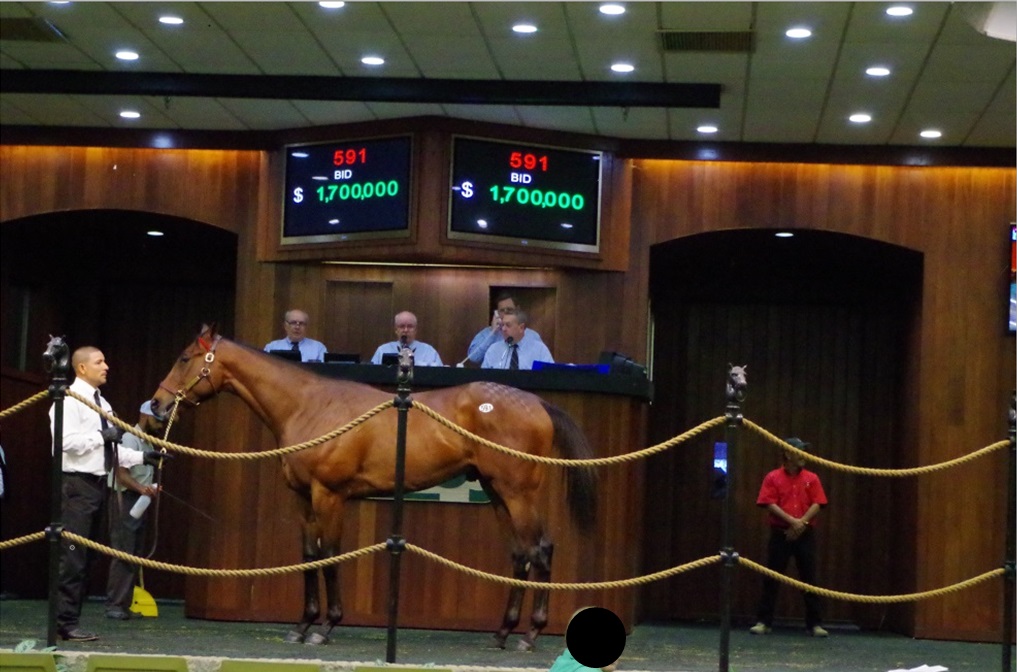If you lay out six figures to purchase a Ferrari, you can be pretty certain that when you step on the gas, it’s going to accelerate faster than just about anything else out there. In other words, spending more money will buy you a faster car. A shocking number of thoroughbred owners approach buying a racehorse much the same way, but it’s not that simple with living, breathing animals. The majority of graded stakes winners, even champions, are purchased for less than $100,000, while the majority of horses purchased for $500,000 - $5,000,000 not only fail to win stakes, but most end up as claiming horses or fail to win a single race!
You can find numerous examples of this every day at most major tracks, but the 4th race at Gulfstream Park on January 6, 2017, a maiden special weight race for four year olds and up at 1&1/16 miles, offers a particularly stark illustration of what paying top dollar does and does not buy with thoroughbred racehorses. Look at the eight runners entered;
|
Horse |
Age |
Purchase Price |
Lifetime Starts |
Lifetime Earnings |
|
Preservationist |
4 |
$485,000 |
1 |
$17,000 |
|
Alasaal |
5 |
$550,000 |
7 |
$16,956 |
|
Frontier Market |
4 |
Not sold |
0 |
$ 0 |
|
Second Street |
4 |
Not Sold |
4 |
$ 3,188 |
|
Travis County |
4 |
$850,000 |
4 |
$26,900 |
|
Alpha Team |
4 |
$400,000 |
2 |
$17,800 |
|
Mr. Chaplin |
4 |
$650,000 |
2 |
$ 2,170 |
|
Salutation |
4 |
$350,000 |
8 |
$10,570 |
|
|
|
|
|
|
|
Totals |
|
$3,285,000 |
28 |
$94,584 |
These 8 horses have made a total of just 28 starts to date between them from age 2-4 (in the case of Alasaal, age 5) and collectively earned under $100,000, compared to their total purchase price of well over $3,000,000. Actually, the numbers are a lot worse. Those totals don’t include the two horses not sold at public auction, Frontier Market and Second Street (both well-bred individuals who likely would have brought a similar amount as the others had they been entered in a sale), nor do they include training expenses on any of the horses (figure at least $60,000 a year per horse given that all are trained by very high-profile trainers based in New York). Add that in and you are talking a total investment of over $5,000,000, with a total return to date of $94,584 (we’ll be kind and not deduct the 10% the jockey and trainer typically receive from the purse earnings!).
Of course, not all horses purchased for top dollar work out this badly. There have certainly been instances of horses purchased for big bucks who have gone on to earn it back and more on the racetrack and in the breeding shed down the road. Spending $500,000++ usually buys you a very well bred, very well conformed yearling or two-year-old with tons of potential. But just like with the tens of thousands of young men every year who dream of earning millions as pros in the NBA or NFL, only a handful of horses make it on the racetrack. For every horse that cost hundreds of thousands or millions of dollars appearing in a stake race, you’ll find (literally) 10 or more in maiden and claiming races at racetracks all over the country.
The bottom line is, if you are going to have any shot of making money in this wonderful but very financially challenging game, it’s not going to be with horses you overpay for. There are a lot of very nice horses which sell for $25,000 - $100,000 +/- at public auction every year. For example, in 2016, Kenwood Racing purchased a total of 9 two year olds at public auction for $385,000 (about $43,000 per horse). Collectively at age two they won five races and earned just about as much money in their first year on the track as the maidens in the 4th race at Gulfstream have in three plus years of racing (and you can be sure they’ll have earned a lot more by the time they are four and five years old)! Remember, they’re racehorses, not racecars, you can’t just step on the gas and make them run faster! Approach the game with a well-thought-out plan, don’t overpay, and you’ll end up with a lot more fun and a lot better results for a lot less money.

Hip 591, a colt by Smart Strike, was the sales topper at OBS March in 2016 for $1,700,000. So far, he has one career start and has earned $332.00.

Comments
Spending more money $$$$$$
Robb. Well said and a lesson you continually point out with excellent examples. This one is so black and white it's alarming.
Thanks for being so passionate about thoroughbreds and Kenwood.
Add new comment